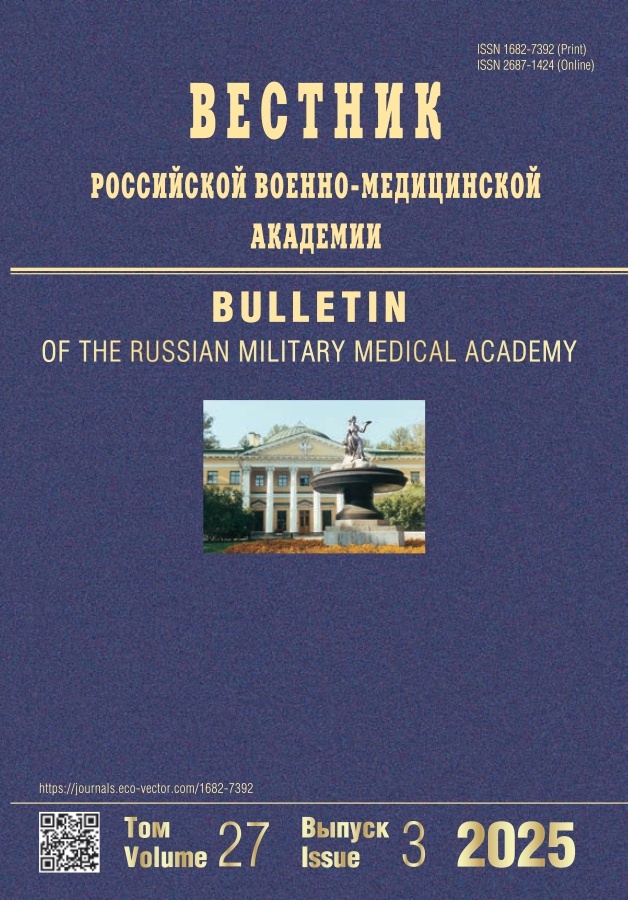Сlinical and epidemiological profiles and tactics of patient’s management with myocardial infarction with non-obstructive coronary arteries
- Authors: Trishkin D.V.1, Shulenin K.S.2, Cherkashin D.V.2, Kutelev G.G.2, Efimov S.V.2, Shishkevich A.N.2, Bobrovskaya E.E.2, Popova A.V.2, Bogdanov D.S.2
-
Affiliations:
- Главное военно-медицинское управление Министерства обороны РФ
- Military medical academy of S.M. Kirov
- Issue: Vol 22, No 4 (2020)
- Pages: 12-16
- Section: Clinical trials
- URL: https://journals.rcsi.science/1682-7392/article/view/62797
- DOI: https://doi.org/10.17816/brmma62797
- ID: 62797
Cite item
Abstract
A comparative analysis of clinical and epidemiological data and results of treatment of 7 patients suffering from myocardial infarction without obstructive coronary artery disease (main group) and 54 patients with their lesions (control group) aged 45,6±9,3 and 62,7±14,2 years, respectively. Both groups were dominated by men (85,7% and 72,2%, respectively). In the main group, dyslipidemia and hypertension were less common (14,3 and 28,6%, respectively) than in the control group (61,1 and 72,2%, respectively). At the same time, the former had a more burdened history of early cardiovascular events in close relatives in 28,6% of cases, and the latter-only in 5,6% of cases. Surgical tactics and features of double antiplatelet therapy in myocardial infarction without obstructive coronary artery disease did not differ from the standard approach. In both groups, active surgical tactics prevailed, consisting in performing percutaneous coronary intervention and installing a coronary stent in the infarct-related artery (85,7 and 83,3%, respectively). The choice of dual antiplatelet therapy in the main group did not differ from the control group and was characterized by a significantly higher frequency of clopidogrel administration (71,4 and 72,2%, respectively). When comparing the left ventricular ejection fraction before and after percutaneous coronary intervention, it turned out that in patients of the main group, in contrast to the control group, the value of the left ventricular ejection fraction did not change significantly (52,5±6,4 and 51,3±9,5, respectively). The etiology and pathogenesis of myocardial damage in patients suffering from myocardial infarction without obstructive coronary artery disease is characterized by significant heterogeneity, which requires additional examinations and differential diagnostics to identify the underlying causes of this condition.
Full Text
##article.viewOnOriginalSite##About the authors
D. V. Trishkin
Главное военно-медицинское управление Министерства обороны РФ
Author for correspondence.
Email: vmeda-nio@mil.ru
Russian Federation, Москва
K. S. Shulenin
Military medical academy of S.M. Kirov
Email: vmeda-nio@mil.ru
Russian Federation, Saint Petersburg
D. V. Cherkashin
Military medical academy of S.M. Kirov
Email: vmeda-nio@mil.ru
Russian Federation, Saint Petersburg
G. G. Kutelev
Military medical academy of S.M. Kirov
Email: vmeda-nio@mil.ru
Russian Federation, Saint Petersburg
S. V. Efimov
Military medical academy of S.M. Kirov
Email: vmeda-nio@mil.ru
Russian Federation, Saint Petersburg
A. N. Shishkevich
Military medical academy of S.M. Kirov
Email: vmeda-nio@mil.ru
Russian Federation, Saint Petersburg
E. E. Bobrovskaya
Military medical academy of S.M. Kirov
Email: vmeda-nio@mil.ru
Russian Federation, Saint Petersburg
A. V. Popova
Military medical academy of S.M. Kirov
Email: vmeda-nio@mil.ru
Russian Federation, Saint Petersburg
D. S. Bogdanov
Military medical academy of S.M. Kirov
Email: vmeda-nio@mil.ru
Russian Federation, Saint Petersburg
References
Supplementary files









